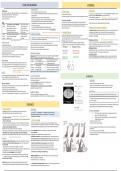Summary
Summary Life Science IEB Evolution notes: making learning easier
- Course
- Institution
I know how overwhelming it is to stare at over 100 pages of evolution notes and not know where to start. Well, start here. I condensed all of the notes into just a few pages (without leaving out any important information). These notes helped me achieve 95% in Life Science for matric and I hope they...
[Show more]



